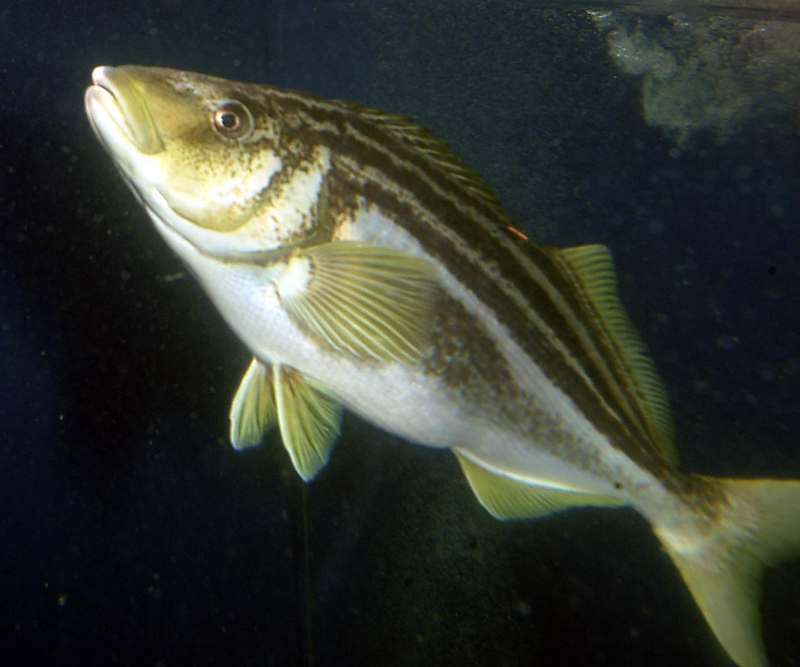Fish Physiology and Genetics
Type of resources
Topics
Keywords
Contact for the resource
Provided by
Years
-

This data represents research conducted as part of a PhD project on captive Striped Trumpeter (Latris lineata). Trials were conducted to investigate hormonal induction of spawning using LHRHa and the effects on testosterone and estradiol in wild and captive fish. Data was also collected on the number and quality of eggs, sperm counts and photo thermal data to record the effect on reproduction.
-

Recorded details of visual field ontology (video images recording feeding response and histology of eye and jaw development), behaviour, feeding and jaw development and malformation in larval striped trumpeter (Latris lineata).
-
Sixty animals were collected from each of Bass Pt, New South Wales (lat 34°35' S, long 150°54' E; August 2000); south side of East Cove, Deal Is, Bass St. (lat 39°28.4' S, long 147°18.4' E; June 2000) and Fortescue Bay, Tasmania (lat 43°8.5' S, long 148°0.0' E; October 2000 and April 2001). To examine the genetic relationship between the three site populations of Centrostephanus rodgersii, allelic diversity and heterozygosity among the three sites was compared using BIOSYS.
-

Data is primarily volume of eggs (naturally spawned and stripped) taken from different photo-thermal held brood stock groups of Striped Trumpeter (Latris lineata). Supporting data includes feeding, animal health and weight and environmental parameters (water quality).
-

This data represents research conducted as part of a PhD project on Striped Trumpeter (Latris lineata). Knowledge of the microbial bacterial community of the larvae, seawater and live feeds is necessary in order to develop an understanding of what represents a healthy microbial ecology relevant for larval fish rearing success. 16S ribosomal RNA (rRNA) gene-based clone library and terminal restriction fragment length polymorphism (TRFLP) analyses were utilized to examine the microbial community associated with larvae cultured under different “greenwater” conditions and determine the success of probiont application in live feeds used for larval fish rearing. Though water quality was apparently influential on larval survival, no specific bacterial species present either on the larvae or in surrounding tank water could be attributed to reduced survival. Two bacterial strains, Pseudoalteromonas sp. ST8 and Vibrio sp. ST7 were found to inhibit bacteria pathogenic to larval fish through production of extracellular substances. Strain ST8 was found to be compatible with artemia, rotifers and larval fish and outcompeted the fish pathogen Vibrio proteolyticus in competition experiments. Encapsulation experiments indicated strain ST8 was transferrable to artemia and thus represent a potential probiont for larval fish mariculture.
-
This study used crosses of wild-caught dumpling squid (Euprymna tasmanica) males to multiple females with known behavioural types to evaluate patterns of additive and residual variance in behavioural traits from offspring under two contexts - a threat and a foraging test. Genetic contributions to behavioural expression were context-dependent. Threat context behaviour had significant heritability, while foraging context behaviour had lesser additive and greater residual components. Female trait variation was not correlated with fecundity. Female foraging boldness (which co-varied with size) explained some variation in brood hatching success. Positive assortion of mate pairs according to shy-bold phenotype determined fertilization success.
-

This data represents research conducted as part of a PhD project on Striped Trumpeter (Latris lineata). Performed morphological histology of swim bladder development in Striped Trumpeter at various ages. Also recorded water temperature, photo period, intensity of light and buoyancy control (in relation to water salinity).
-

This data represents research conducted as part of a PhD project on Striped Trumpeter (Latris lineata). Recorded optimal temperatures and lipid levels in diets, protein levels, growth and survival and body composition analysis for post larval striped trumpeter. Also investigated optimal weaning protocol and recorded post larval metamorphosis data.
-
This data represents research conducted as part of a PhD project on Greenback flounder (Rhombosolea tapirina). Larvae were reared in either green water (Tetraselmis suecica) or clear water tanks during short-term feeding trials to investigate the effect of larval culture history, live prey density, and turbidity level on feeding performance.
-

Data collected includes growth, survival, development (swim bladder inflation, flexion, metamorphosis), health, water quality, systems (tank size etc), nutrition (live feeds, lipids, vitamins) for hatchery reared striped trumpeter (Latris lineata).
 IMAS Metadata Catalogue
IMAS Metadata Catalogue